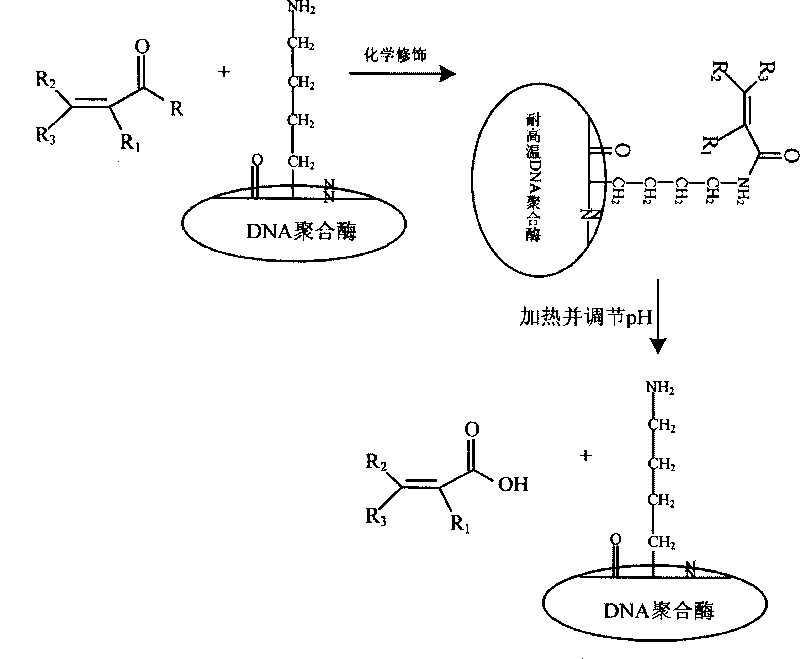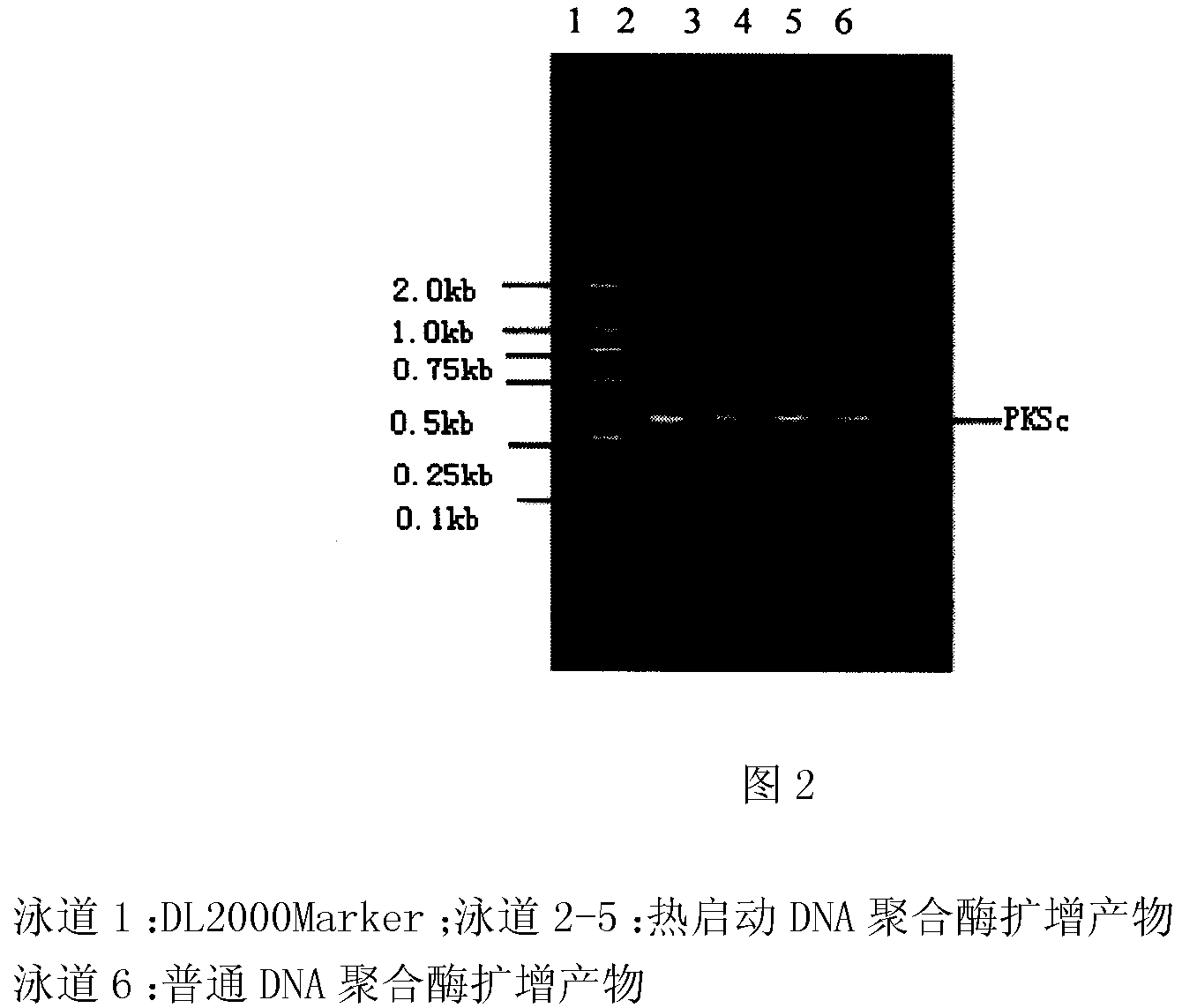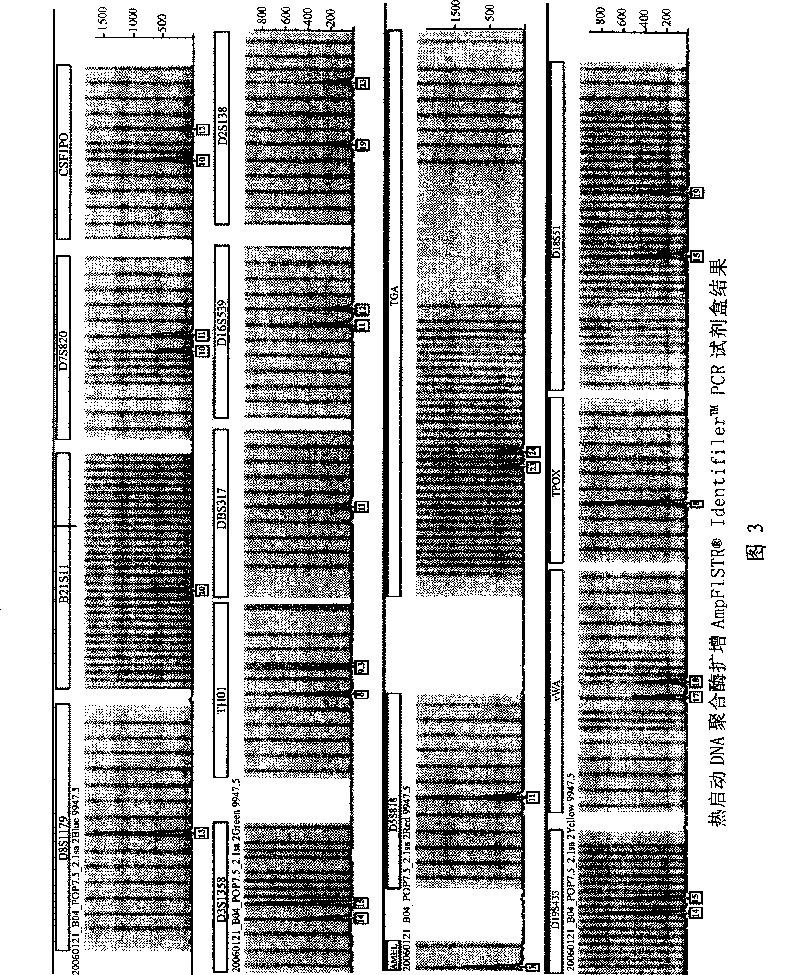Warm start high temperature resistant DNA polymerase, and preparation method
A high-temperature, polymerase technology, applied in the field of protein chemistry in biochemistry, can solve the problems of loss of hot-start effect, poor hot-start effect, cumbersome operation, etc., achieve high retention rate of original enzyme activity, improve production efficiency, and reduce costs. Effect
- Summary
- Abstract
- Description
- Claims
- Application Information
AI Technical Summary
Problems solved by technology
Method used
Image
Examples
Embodiment 1
[0024] 1. 2-methyl-2-butene-2-acid succinic anhydride or 2-methyl-2-butene-2-acid-2,3,4,5,6 pentafluorophenolic anhydride modified high temperature resistant DNA Polymerase (Taq enzyme) protein produces a hot start high temperature resistant DNA polymerase. The specific production steps are as follows:
[0025] The structural formula of 2-methyl-2-butene-2-acid succinic anhydride is as follows:
[0026]
[0027] 2-Methyl-2-butene-2-acid succinic anhydride
[0028] The structural formula of 2-methyl-2-butene-2-acid-2,3,4,5,6 pentafluorophenolic anhydride is as follows:
[0029]
[0030] 2-Methyl-2-butene-2-acid 2,3,4,5,6-pentafluorophenol anhydride
[0031] 2. Take the high-temperature-resistant DNA polymerase (Taq enzyme) from Promega Company, the enzyme protein concentration is 50 mg / ml, and the Taq enzyme activity is determined to be 180 U / ul.
[0032] 3. Weigh 50 mg of 2-methyl-2-butene-2-acid succinic anhydride or 2-methyl-2-butene-2-acid-2,3,4,5,6 pentafluorophen...
Embodiment 2
[0037]1. 2,4-Hexadienoic acid succinic anhydride or 2,4-Hexadienoic acid-2,3,4,5,6 pentafluorophenolic anhydride modify high temperature resistant DNA polymerase (Taq enzyme) protein to produce hot start high temperature resistant DNA polymerization enzyme. The specific production steps are as follows:
[0038] The structural formula of 2,4-hexadienoic acid succinic anhydride is as follows:
[0039]
[0040] 2,4-Hexadienoic acid succinic anhydride
[0041] The structural formula of 2,4-hexadienoic acid-2,3,4,5,6 pentafluorophenolic anhydride is as follows:
[0042]
[0043] 2,4-Hexadienoic acid-2,3,4,5,6-pentafluorophenolic anhydride
[0044] 2. Take the high-temperature-resistant DNA polymerase (Taq enzyme) from Promega Company, the enzyme protein concentration is 50 mg / ml, and the Taq enzyme activity is determined to be 180 U / ul.
[0045] 3. Weigh 25 mg of 2,4-hexadienoic acid succinic anhydride or 2,4-hexadienoic acid-2,3,4,5,6 pentafluorophenolic anhydride, and a...
Embodiment 3
[0050] 1. Modify the high temperature resistant DNA polymerase (Taq enzyme) protein with 3,5-dinitrosalicylic acid succinic anhydride or 3,5-dinitrosalicylic acid p-nitrophenolic anhydride to produce hot start high temperature resistant DNA polymerase. The specific production steps are as follows:
[0051] The structural formula of 3,5-dinitrosalicylic acid succinic anhydride is as follows:
[0052]
[0053] 3,5-Dinitrosalicylic acid succinic anhydride
[0054] The structural formula of 3,5--dinitrosalicylic acid p-nitrophenol anhydride is as follows:
[0055]
[0056] 3,5-Dinitrosalicylic acid p-nitrophenol anhydride
[0057] 2. Take the high-temperature-resistant DNA polymerase (Taq enzyme) from Takara Company, the enzyme protein concentration is 30 mg / ml, and the Taq enzyme activity is determined to be 100 U / ul.
[0058] 3. Weigh 1 mg of 3,5-dinitrosalicylic acid succinic anhydride or 3,5-dinitrosalicylic acid p-nitrophenol anhydride, and add it to 50ul of dimethy...
PUM
 Login to View More
Login to View More Abstract
Description
Claims
Application Information
 Login to View More
Login to View More - R&D
- Intellectual Property
- Life Sciences
- Materials
- Tech Scout
- Unparalleled Data Quality
- Higher Quality Content
- 60% Fewer Hallucinations
Browse by: Latest US Patents, China's latest patents, Technical Efficacy Thesaurus, Application Domain, Technology Topic, Popular Technical Reports.
© 2025 PatSnap. All rights reserved.Legal|Privacy policy|Modern Slavery Act Transparency Statement|Sitemap|About US| Contact US: help@patsnap.com



